2016 Hyundai Santa Fe coolant
[x] Cancel search: coolantPage 675 of 759

733
Maintenance
Check the condition and connections
of all cooling system hoses and
heater hoses. Replace any swollen
or deteriorated hoses.
The coolant level should be filled
between F (MAX) and L (MIN) marks
on the side of the coolant reservoir
when the engine is cool.
If the coolant level is low, add enough
distilled (deionized) water. Bring the
level to F (MAX), but do not overfill.
If frequent coolant refill is required,
see an authorized HYUNDAI dealer
for a cooling system inspection.
Recommended engine coolant
When adding coolant, use onlydeionized water for your vehicle
and never mix hard water in the
coolant filled at the factory. An
improper coolant mixture can
result in serious malfunction or
engine damage.
The engine in your vehicle has alu- minum engine parts and must be
protected by an ethylene-glycol-
based coolant to prevent corrosion
and freezing.
DO NOT USE alcohol or methanol coolant or mix them with the spec-
ified coolant.
Do not use a solution that contains more than 60% antifreeze or less
than 35% antifreeze, which would
reduce the effectiveness of the
solution. For mixture percentage, refer to the
following table.
ODM073006
Ambient
Temperature Mixture Percentage
(volume)
Antifreeze Water
5°F (-15°C) 35 65
-13°F (-25°C) 40 60
-31°F (-35°C) 50 50
-49°F (-45°C) 60 40
Page 676 of 759

Maintenance
34
7
Changing the coolant
Have coolant changed by an author-
ized HYUNDAI dealer according to
the Maintenance Schedule at the
beginning of this section.
WARNING
Radiator cap
Do not remove the radiator cap
when the engine and radiator
are hot. Scalding hot coolant
and steam may blow out under
pressure causing serious
injury.
CAUTION
Put a thick cloth or fabric
around the radiator cap beforerefilling the coolant in order toprevent the coolant from over-flowing into engine parts suchas generator.
WARNING - Coolant
Do not use radiator coolant or antifreeze in the washer fluid
reservoir.
Radiator coolant can severely obscure visibility when
sprayed on the windshield
and may cause loss of vehicle
control or damage to paint
and body trim.
ONCNMC2007
Page 679 of 759
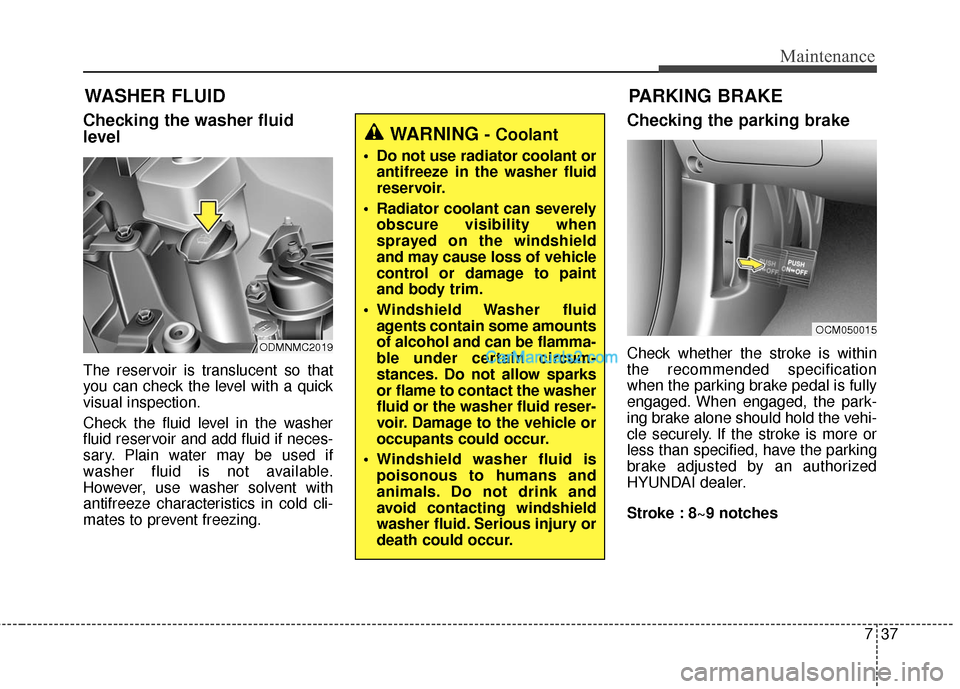
737
Maintenance
WASHER FLUID
Checking the washer fluid
level
The reservoir is translucent so that
you can check the level with a quick
visual inspection.
Check the fluid level in the washer
fluid reservoir and add fluid if neces-
sary. Plain water may be used if
washer fluid is not available.
However, use washer solvent with
antifreeze characteristics in cold cli-
mates to prevent freezing.
Checking the parking brake
Check whether the stroke is within
the recommended specification
when the parking brake pedal is fully
engaged. When engaged, the park-
ing brake alone should hold the vehi-
cle securely. If the stroke is more or
less than specified, have the parking
brake adjusted by an authorized
HYUNDAI dealer.
Stroke : 8~9 notchesODMNMC2019
WARNING - Coolant
Do not use radiator coolant orantifreeze in the washer fluid
reservoir.
Radiator coolant can severely obscure visibility when
sprayed on the windshield
and may cause loss of vehicle
control or damage to paint
and body trim.
Windshield Washer fluid agents contain some amounts
of alcohol and can be flamma-
ble under certain circum-
stances. Do not allow sparks
or flame to contact the washer
fluid or the washer fluid reser-
voir. Damage to the vehicle or
occupants could occur.
Windshield washer fluid is poisonous to humans and
animals. Do not drink and
avoid contacting windshield
washer fluid. Serious injury or
death could occur.
PARKING BRAKE
OCM050015
Page 700 of 759
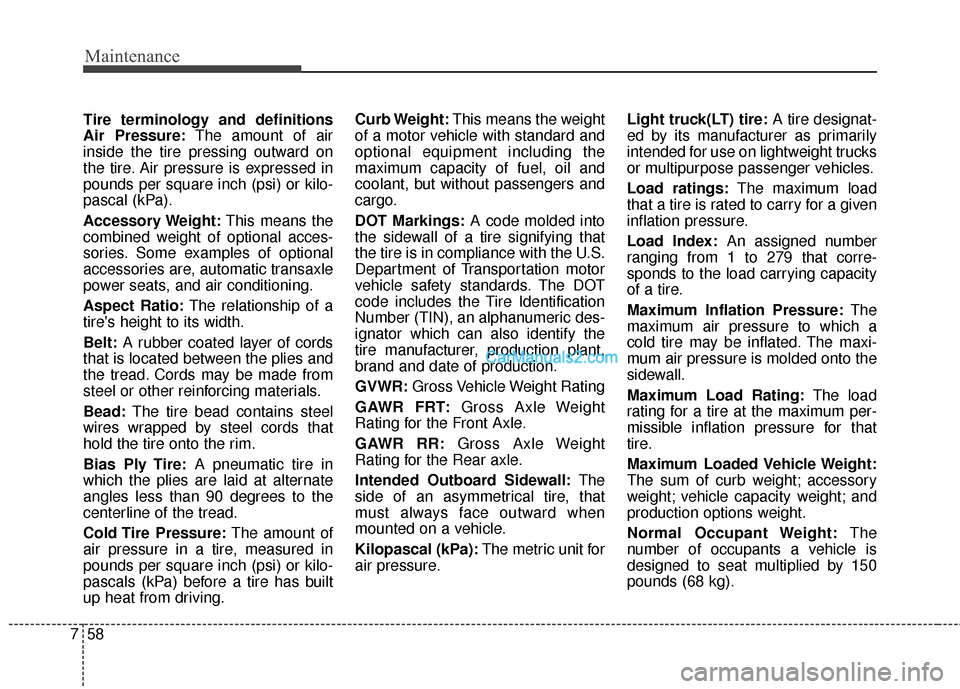
Maintenance
58
7
Tire terminology and definitions
Air Pressure: The amount of air
inside the tire pressing outward on
the tire. Air pressure is expressed in
pounds per square inch (psi) or kilo-
pascal (kPa).
Accessory Weight: This means the
combined weight of optional acces-
sories. Some examples of optional
accessories are, automatic transaxle
power seats, and air conditioning.
Aspect Ratio: The relationship of a
tire's height to its width.
Belt: A rubber coated layer of cords
that is located between the plies and
the tread. Cords may be made from
steel or other reinforcing materials.
Bead: The tire bead contains steel
wires wrapped by steel cords that
hold the tire onto the rim.
Bias Ply Tire: A pneumatic tire in
which the plies are laid at alternate
angles less than 90 degrees to the
centerline of the tread.
Cold Tire Pressure: The amount of
air pressure in a tire, measured in
pounds per square inch (psi) or kilo-
pascals (kPa) before a tire has built
up heat from driving. Curb Weight:
This means the weight
of a motor vehicle with standard and
optional equipment including the
maximum capacity of fuel, oil and
coolant, but without passengers and
cargo.
DOT Markings: A code molded into
the sidewall of a tire signifying that
the tire is in compliance with the U.S.
Department of Transportation motor
vehicle safety standards. The DOT
code includes the Tire Identification
Number (TIN), an alphanumeric des-
ignator which can also identify the
tire manufacturer, production plant,
brand and date of production.
GVWR: Gross Vehicle Weight Rating
GAWR FRT: Gross Axle Weight
Rating for the Front Axle.
GAWR RR: Gross Axle Weight
Rating for the Rear axle.
Intended Outboard Sidewall: The
side of an asymmetrical tire, that
must always face outward when
mounted on a vehicle.
Kilopascal (kPa): The metric unit for
air pressure. Light truck(LT) tire:
A tire designat-
ed by its manufacturer as primarily
intended for use on lightweight trucks
or multipurpose passenger vehicles.
Load ratings: The maximum load
that a tire is rated to carry for a given
inflation pressure.
Load Index: An assigned number
ranging from 1 to 279 that corre-
sponds to the load carrying capacity
of a tire.
Maximum Inflation Pressure: The
maximum air pressure to which a
cold tire may be inflated. The maxi-
mum air pressure is molded onto the
sidewall.
Maximum Load Rating: The load
rating for a tire at the maximum per-
missible inflation pressure for that
tire.
Maximum Loaded Vehicle Weight:
The sum of curb weight; accessory
weight; vehicle capacity weight; and
production options weight.
Normal Occupant Weight: The
number of occupants a vehicle is
designed to seat multiplied by 150
pounds (68 kg).
Page 734 of 759
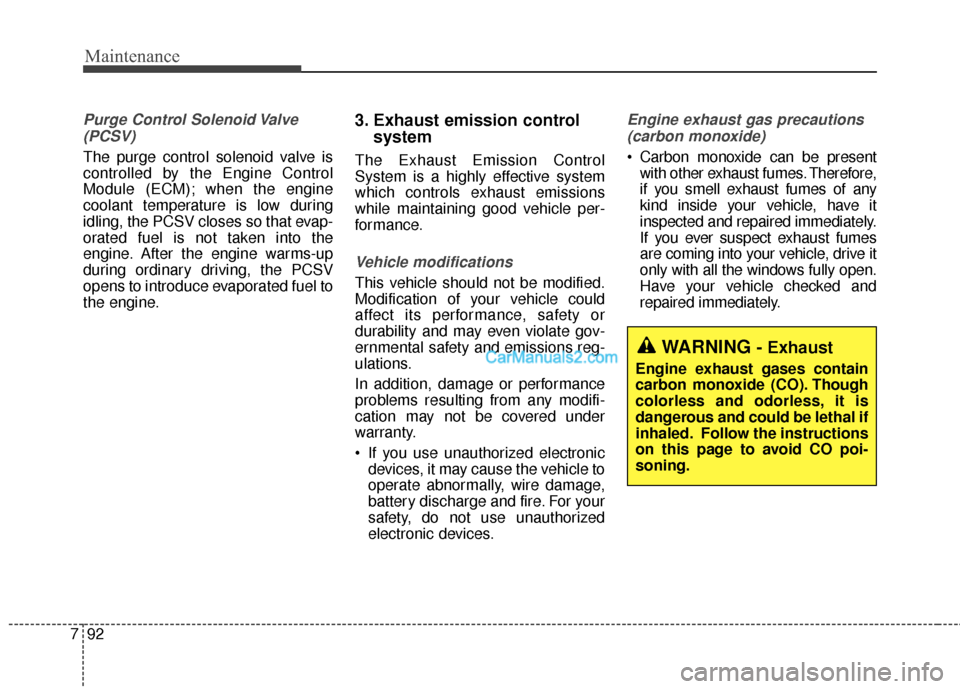
Maintenance
92
7
Purge Control Solenoid Valve
(PCSV)
The purge control solenoid valve is
controlled by the Engine Control
Module (ECM); when the engine
coolant temperature is low during
idling, the PCSV closes so that evap-
orated fuel is not taken into the
engine. After the engine warms-up
during ordinary driving, the PCSV
opens to introduce evaporated fuel to
the engine.
3. Exhaust emission control system
The Exhaust Emission Control
System is a highly effective system
which controls exhaust emissions
while maintaining good vehicle per-
formance.
Vehicle modifications
This vehicle should not be modified.
Modification of your vehicle could
affect its performance, safety or
durability and may even violate gov-
ernmental safety and emissions reg-
ulations.
In addition, damage or performance
problems resulting from any modifi-
cation may not be covered under
warranty.
If you use unauthorized electronic
devices, it may cause the vehicle to
operate abnormally, wire damage,
battery discharge and fire. For your
safety, do not use unauthorized
electronic devices.
Engine exhaust gas precautions
(carbon monoxide)
Carbon monoxide can be present with other exhaust fumes. Therefore,
if you smell exhaust fumes of any
kind inside your vehicle, have it
inspected and repaired immediately.
If you ever suspect exhaust fumes
are coming into your vehicle, drive it
only with all the windows fully open.
Have your vehicle checked and
repaired immediately.
WARNING - Exhaust
Engine exhaust gases contain
carbon monoxide (CO). Though
colorless and odorless, it is
dangerous and could be lethal if
inhaled. Follow the instructions
on this page to avoid CO poi-
soning.
Page 743 of 759
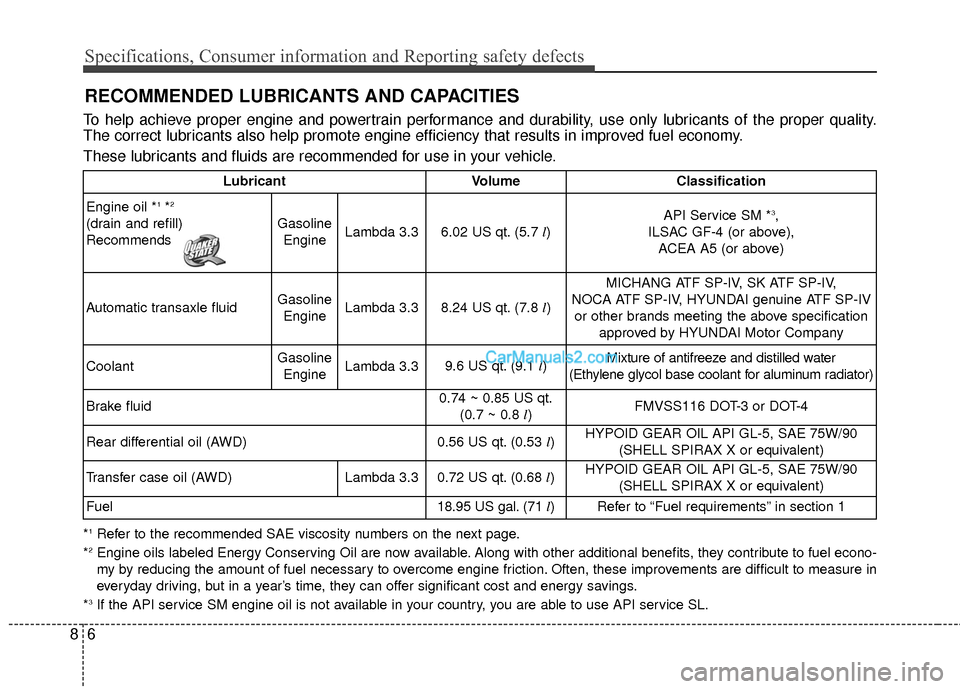
Specifications, Consumer information and Reporting safety defects
68
RECOMMENDED LUBRICANTS AND CAPACITIES
*1Refer to the recommended SAE viscosity numbers on the next page.
*2Engine oils labeled Energy Conserving Oil are now available. Along with other additional benefits, they contribute to fuel econo -
my by reducing the amount of fuel necessary to overcome engine friction. Often, these improvements are difficult to measure in
everyday driving, but in a year’s time, they can offer significant cost and energy savings.
*
3If the API service SM engine oil is not available in your country, you are able to use API service SL.
To help achieve proper engine and powertrain performance and durability, use only lubricants of the proper quality.
The correct lubricants also help promote engine efficiency that results in improved fuel economy.
These lubricants and fluids are recommended for use in your vehicle.
Lubricant VolumeClassification
Engine oil *
1*2
(drain and refill)
Recommends Gasoline
Engine Lambda 3.3
6.02 US qt. (5.7
l) API Service SM *3,
ILSAC GF-4 (or above), ACEA A5 (or above)
Automatic transaxle fluid Gasoline
Engine Lambda 3.3
8.24 US qt. (7.8
l)MICHANG ATF SP-IV, SK ATF SP-IV,
NOCA ATF SP-IV, HYUNDAI genuine ATF SP-IV or other brands meeting the above specification approved by HYUNDAI Motor Company
Coolant Gasoline
Engine Lambda 3.3
9.6 US qt. (9.1
l)Mixture of antifreeze and distilled water
(Ethylene glycol base coolant for aluminum radiator)
Brake fluid0.74 ~ 0.85 US qt. (0.7 ~ 0.8 l)FMVSS116 DOT-3 or DOT-4
Rear differential oil (AWD) 0.56 US qt. (0.53 l)HYPOID GEAR OIL API GL-5, SAE 75W/90
(SHELL SPIRAX X or equivalent)
Transfer case oil (AWD) Lambda 3.30.72 US qt. (0.68
l)HYPOID GEAR OIL API GL-5, SAE 75W/90
(SHELL SPIRAX X or equivalent)
Fuel18.95 US gal. (71 l)Refer to “Fuel requirements” in section 1
Page 751 of 759
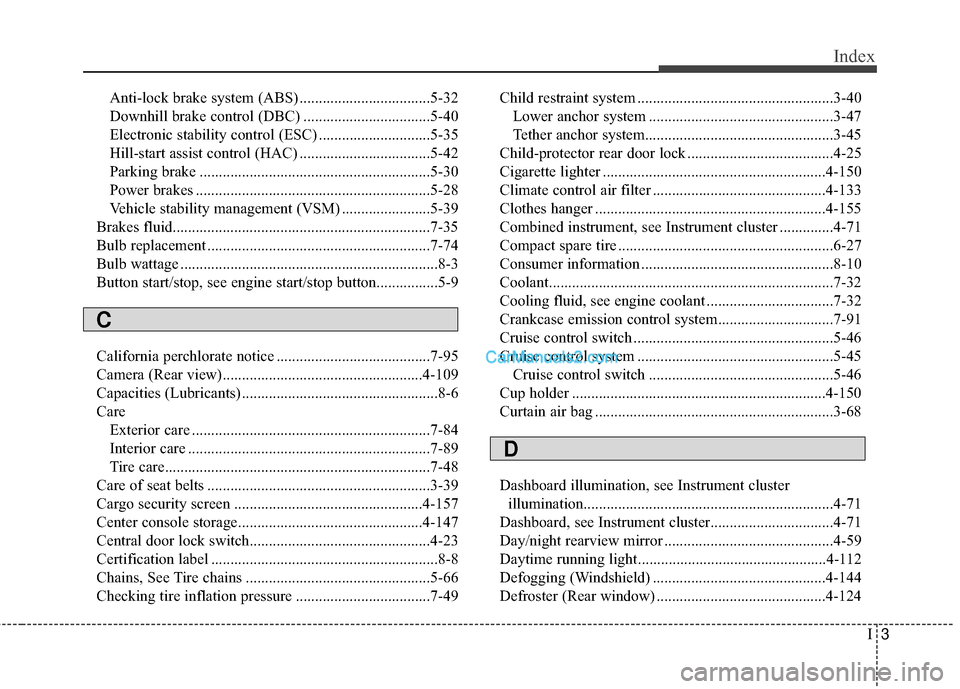
I3
Index
Anti-lock brake system (ABS) ..................................5-32
Downhill brake control (DBC) .................................5-40
Electronic stability control (ESC) .............................5-35
Hill-start assist control (HAC) ..................................5-42
Parking brake ............................................................5-30
Power brakes .............................................................5-28
Vehicle stability management (VSM) .......................5-39
Brakes fluid............................................................\
.......7-35
Bulb replacement ..........................................................7-74
Bulb wattage ...................................................................8-3
Button start/stop, see engine start/stop button................5-9
California perchlorate notice ........................................7-95
Camera (Rear view)....................................................4-109
Capacities (Lubricants) ...................................................8-6
Care Exterior care ..............................................................7-84
Interior care ...............................................................7-89
Tire care.....................................................................7-4\
8
Care of seat belts ..........................................................3-39
Cargo security screen .................................................4-157
Center console storage................................................4-147
Central door lock switch...............................................4-23
Certification label ...........................................................8-8
Chains, See Tire chains ................................................5-66
Checking tire inflation pressure ...................................7-49 Child restraint system ...................................................3-40
Lower anchor system ................................................3-47
Tether anchor system.................................................3-45
Child-protector rear door lock ......................................4-25
Cigarette lighter ..........................................................4-150
Climate control air filter .............................................4-133
Clothes hanger ............................................................4-155
Combined instrument, see Instrument cluster ..............4-71
Compact spare tire ........................................................6-27
Consumer information ..................................................8-10
Coolant........................................................................\
..7-32
Cooling fluid, see engine coolant .................................7-32
Crankcase emission control system..............................7-91
Cruise control switch ....................................................5-46
Cruise control system ...................................................5-45 Cruise control switch ................................................5-46
Cup holder ..................................................................4-150
Curtain air bag ..............................................................3-68
Dashboard illumination, see Instrument cluster illumination.................................................................4-71
Dashboard, see Instrument cluster................................4-71
Day/night rearview mirror ............................................4-59
Daytime running light.................................................4-112
Defogging (Windshield) .............................................4-144
Defroster (Rear window) ............................................4-124
C
D
Page 752 of 759
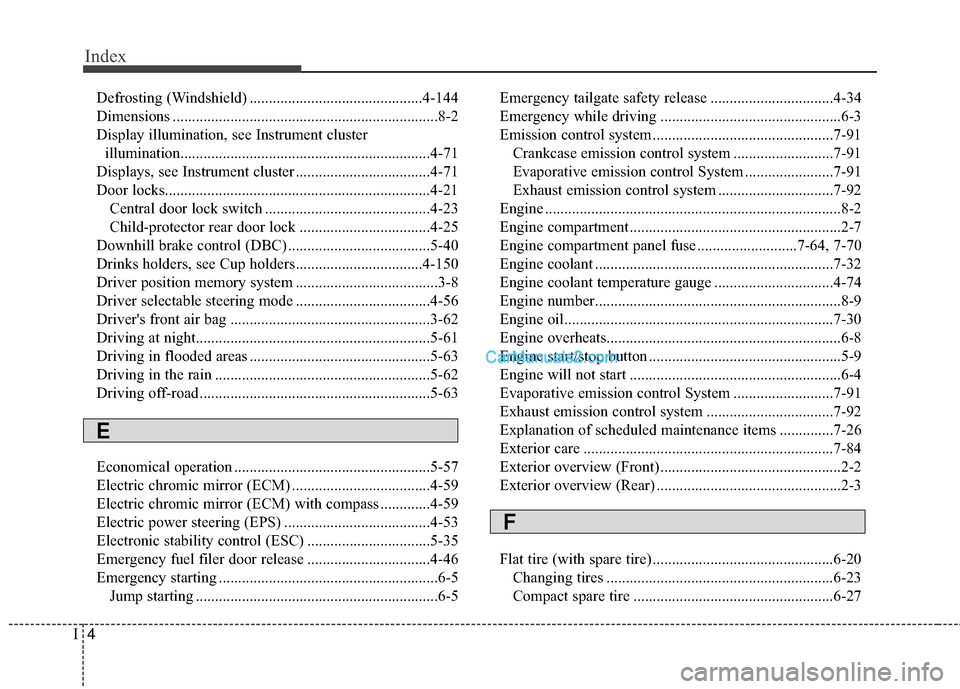
Index
4I
Defrosting (Windshield) .............................................4-144
Dimensions .....................................................................8-2\
Display illumination, see Instrument cluster illumination.................................................................4-71
Displays, see Instrument cluster ...................................4-71
Door locks..............................................................\
.......4-21 Central door lock switch ...........................................4-23
Child-protector rear door lock ..................................4-25
Downhill brake control (DBC) .....................................5-40
Drinks holders, see Cup holders.................................4-150
Driver position memory system .....................................3-8
Driver selectable steering mode ...................................4-56
Driver's front air bag ....................................................3-62
Driving at night.............................................................5-61
Driving in flooded areas ...............................................5-63
Driving in the rain ........................................................5-62
Driving off-road ............................................................5-63
Economical operation ...................................................5-57
Electric chromic mirror (ECM) ....................................4-59
Electric chromic mirror (ECM) with compass .............4-59
Electric power steering (EPS) ......................................4-53
Electronic stability control (ESC) ................................5-35
Emergency fuel filer door release ................................4-46
Emergency starting .........................................................6-5 Jump starting ...............................................................6-5 Emergency tailgate safety release ................................4-34
Emergency while driving ...............................................6-3
Emission control system ...............................................7-91
Crankcase emission control system ..........................7-91
Evaporative emission control System .......................7-91
Exhaust emission control system ..............................7-92
Engine ........................................................................\
.....8-2
Engine compartment .......................................................2-7
Engine compartment panel fuse ..........................7-64, 7-70
Engine coolant ..............................................................7-32
Engine coolant temperature gauge ...............................4-74
Engine number................................................................8-9
Engine oil......................................................................7-\
30
Engine overheats.............................................................6-8
Engine start/stop button ..................................................5-9
Engine will not start .......................................................6-4
Evaporative emission control System ..........................7-91
Exhaust emission control system .................................7-92
Explanation of scheduled maintenance items ..............7-26
Exterior care .................................................................7-84
Exterior overview (Front) ...............................................2-2
Exterior overview (Rear) ................................................2-3
Flat tire (with spare tire) ...............................................6-20 Changing tires ...........................................................6-23
Compact spare tire ....................................................6-27
E
F